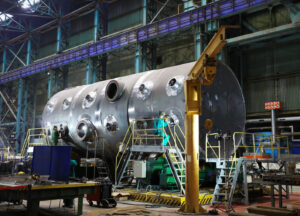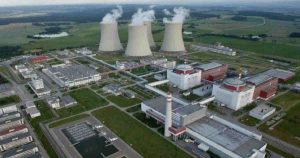Some low-lying plants face a watery future, but the legacy of Fukushima is spurring action.
The San Onofre plant on California’s coast has shutdown, but there’s disagreement over storing its toxic waste close to the shoreline.
Photograph by Mark Boster, Los Angeles Times, Getty Images
Just east of the Homestead-Miami Speedway, off Florida’s Biscayne Bay, two nuclear reactors churn out enough electricity to power nearly a million homes. The Turkey Point plant is licensed to continue doing so until at least 2032.
At some point after that, if you believe the direst government projections, a good part of the low-lying site could be underwater. So could at least 13 other U.S. nuclear plants, as the world’s seas continue to rise.
Their vulnerability, and that of many others, raises serious questions for the future. The new UN climate accord, reached over the weekend after two weeks of talks in Paris, prods countries to shift from fossil fuels toward energy sources that emit zero planet-warming carbon emissions.
Nuclear could be part of the solution, because it can deliver large, steady amounts of carbon-free electricity. That’s why China, the world’s largest carbon emitter, aims to expand its nuclear capacity by spending $78 billion to add six to eight nuclear reactors each year for five years.
Then again, safety concerns have stoked opposition to nuclear. Reactors can’t operate safely without uninterrupted power and vast amounts of cool water, which is why they’re often located near coastlines, rivers, and lakes. Even when a plant isn’t running, its fuel continues to generate heat that needs to be controlled to prevent explosions or radioactive leaks.
The disaster at Japan’s Fukushima Daiichi showed what can happen when a massive surge of water hits a nuclear plant. Seas of nearly 50 feet washed over it during the 2011 earthquake and tsunami, knocking out the power needed to run its cooling systems. A last-resort bank of batteries lasted only eight hours. As a result, three reactors suffered partial meltdowns and radiation leaked into the air and ocean.
The event gave nuclear a black eye, prompting countries worldwide to take a closer look at their power plants. In the United Kingdom, for example, a pair of reactors were taken offline in 2013 because of concerns that an extreme event could overwhelm its seawall, which was then improved.
The United States has 100 operational nuclear reactors, and another 17 that are being decommissioned. In the past, historical data about storms and flooding would inform the licensing requirements for a unit.
“We generally thought that backward look was sufficient,” says Dave Lochbaum, director of the Nuclear Safety Project at the nonprofit Union of Concerned Scientists. Fukushima and big storms like Hurricane Sandy in 2012 showed “that’s a tenuous assumption at best.”
The industry is now reevaluating its flood risks, and hatched a strategy it calls FLEX, where key backup equipment is stationed at multiple locations so it can be shuttled to a distressed plant. This way, instead of defining a theoretical crisis—a storm surge of a certain height, a hurricane by category—ahead of time, says Jim Riley of the industry’s Nuclear Energy Institute, “we’re saying, give us the event and we’ll deploy the equipment.”
Some think more needs to be done, faster. “The Nuclear Regulatory Commission has been slow to implement those Fukushima lessons learned,” says Matthew McKinzie, nuclear program director at the environmental group Natural Resources Defense Council. “Nuclear safety is a work in progress.”
Researchers at Stanford University echoed that concern in 2013, flagging four East Coast plants (the Salem and Hope Creek plants in New Jersey; Millstone in Connecticut; and Seabrook in New Hampshire) as especially vulnerable to storm surges and arguing for, among other measures, more and taller seawalls. A more recent analysis from the Union of Concerned Scientists found that at least four nuclear plants are vulnerable to storm surges by 2050.
The NRC is considering two new rules, one based on post-Fukushima safety orders issued in 2012, and another that would create new standards related to decommissioning.
The former rule, to be finalized at the end of next year, requires “an extra level of defense for a plant to deal with events that could interfere with ability to keep the core cool,” says Nuclear Regulatory Commission spokesperson Scott Burnell. That defense includes portable backup power generators, battery banks, and additional supplies if needed.
U.S. plants have been “battle-tested,” says Tom Kauffman, NEI’s director of media relations. “We don’t really have to deal in hypotheticals here,” he says, citing safe, preventive shutdowns that occurred during storms such as Sandy and Katrina. “We have not yet met our match.”
Some plants have already made changes. At the low-lying Millstone plant in Connecticut, operator Dominion has put in moveable flood barriers, water-tight doors, and made equipment among different plants more interchangeable so that it can be replaced in an emergency.
The more immediate concern from climate change, says Dominion spokesperson Ken Holt, is the water near Millstone getting too warm. One of its units had to shut down temporarily in 2012, because its intake from the Niantic Bay exceeded 75 degrees. It’s a problem that has affected other plants, too.
“I’d say that is probably affecting more plants than sea level rise at this point,” Holt says.
Retiring Plants, Encroaching Seas
Millstone and Turkey Point will likely have reached the end of their lives before sea levels rise to a point where flooding becomes harder and harder to stave off. Estimates for how quickly sea levels could rise vary widely, from up to 4 feet by 2100 to almost 30 feet anywhere between the next two centuries and 2,000 years from now.
Even if the plants aren’t running, though, the industry will need to address the radioactive waste left behind.
The question of what happens with spent fuel left at shuttered nuclear plants is, Lochbaum says, “the biggest wild card.”
He adds: “We do have a number of plants around the country where the spent fuel may remain there for decades, and nature may not give us that much time.”
The concern is that the shorter-term pools used to cool spent fuel rods require continuously circulated water. Loss of power at Fukushima, for example, led to urgent efforts to keep the water in the spent fuel pools from boiling away.
After a few years, fuel can be moved from pools to dry casks made of steel reinforced with concrete. Though the safety risk for casks is much lower—all of Fukushima’s emerged unscathed—some are concerned about how long those casks can remain safe at vulnerable sites, especially those buffeted by salty sea air. At the decommissioned San Onofre plant in California, for example, local activists tried but failed to stop plans to store nuclear waste 100 feet from the coast.
McKinzie says the NRDC is pushing regulators to address the impact of not having a permanent, deep geological storage plan for waste that can have a half-life extending thousands of years. Efforts to establish a federal repository such as the defeated Yucca Mountain plan in Nevada have been stymied by political opposition.
“You have to deal with this. You have to isolate this material from people and the environment,” McKinzie says, “and at the moment we’re just making more of it without that solution.”
The NRC’s proposed rule would create a standard for decommissioning, rather than the current plant-by-plant approach, says Burnell.
Both the industry and the NRC argue that there is ample time to address the long-term effects of sea level rise. Take the Turkey Point plant, which looks so watery in NOAA’s six-foot-rise scenario. NRC spokesman Scott Burnell says the plant’s reactors, safety systems, and electric switchyard would still be dry, “so the plant would remain safe.”
Turkey Point’s operator, Florida Power and Light, says the plant is protected to 20 feet above sea level. In fact, it’s pursuing plans to add two more reactors to the site.
New nuclear plants will be more forward-looking—built on higher, drier sites. They might even skirt storm risks altogether by floating offshore, or using molten salt technology that can withstand power losses with no chance of a meltdown.
For older plants, though, the future will be more fraught. With competition from natural gas and renewables, the cost of putting in new equipment upgrades or seawalls at an existing plant, Lochbaum says, “could be the cost that’s just too much and causes the plant to shut down early.”
The story is part of a special series that explores energy issues. For more, visit The Great Energy Challenge, reports internet.




